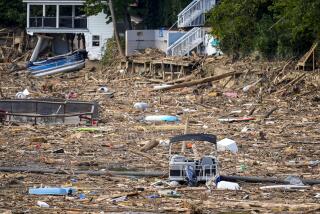A scenic corner of Quechee, Vt., is gone
- Share via
Reporting from Quechee, Vt. — Nestled between the ski slopes of Killington, the antique shops of Woodstock and the state’s most cavernous gorge, a quiet corner of Main Street here overlooks the Ottauquechee River, a well-traveled stop that draws tourists all year, especially as the leaves turn.
It’s where glassblower Simon Pearce set up shop in an 1800s woolen mill and turned the upstairs into an elegant glass-fronted restaurant. It’s where Barbara West opened her real estate business in the 1980s with large windows offering a glimpse of the town’s waterfall. And it is where Adam and Alexandra La-Noue Adler chose to open their Parker House Inn & Restaurant in 2004, where guests can watch the river glide by from rocking chairs on the porch.
Photos: Hurricane Irene cleanup begins
Hurricane Irene’s flash floods shattered that calm Sunday, sending the Ottauquechee River surging up its banks with a force no one here thought possible. It took a generous slice of that scenic corner, the bridge that connects it to the main tourist thoroughfare, and pieces of New England history with it.
The mammoth hurricane that was predicted to take a hard swipe at the Eastern Seaboard instead pummeled the inland Northeast, particularly Vermont, causing widespread and devastating floods. In the Green Mountain State, where mills and factories long ago gave way to a tourism-heavy economy powered by skiers, hikers and leaf-peepers, scores of roads were impassable and officials were hoping residents would be able to access 13 isolated towns by Tuesday night.
The total economic toll was still difficult to gauge. The Insurance Institute, an industry trade group, estimated losses at $2 billion to $5 billion. Another catastrophe modeling firm put it between $3 billion and $6 billion. And Peter Morici, former chief economist at the U.S. International Trade Commission, figured the cost to be significantly higher: as much as $20 billion, with lost economic activity possibly doubling that figure.
As Federal Emergency Management Agency chief Craig Fugate arrived in Vermont, the human toll of Hurricane Irene had climbed to 44 deaths in 13 states, including at least three in Vermont, according to the Associated Press. Utility crews were working to restore power to hundreds of thousands of customers in Vermont, New York, New Jersey and other parts of the Northeast. About 16,000 evacuees were still in emergency shelters.
Vermont Gov. Peter Shumlin posted a cheerful message on his Facebook page saying Vermont was “open for business.” But business owners along Quechee’s Main Street were facing a more crushing reality.
The Ottauquechee River’s surge Sunday tore through a corner of the old mill that houses the Simon Pearce shop, destroying the glassblowing furnace in the downstairs factory that drew thousands of tourists annually, many of them children, who had watched wide-eyed as candlesticks and glass bowls were fashioned before them by hand.
The rising water, which encircled all three businesses on the corner like a fast-moving lake, took out plate glass windows and flooring that formed the front half of West’s real estate building, leaving a surreal scene of desks and tables suspended in the open air above the falls.
The flooding at the Adlers’ inn, which lapped at the bottom of their porch and left them with barely enough time to get out, swept out their wine cellar and pantry.
Also gone was half of the gray covered bridge that serves as the main connection for the businesses to Route 4, the town’s primary tourist thoroughfare, blocked by damage just a few miles to the west. Only a lesser-known back road gives travelers access to the town. Farther down the river, Quechee Gorge had been transformed from a loud, rushing ribbon of water normally 165 feet below the bridge to a still, brackish pool full of half-submerged pine trees.
For Alexandra La-Noue Adler, who doubles as innkeeper and chef at the Parker House, the view of devastation from her porch was almost too much to bear.
Between cellphone calls from emergency management officials and asides over the railing to her husband, who was pulling muddy linens, chairs and cookbooks from the flooded first floor, she said insurance would cover almost nothing.
The couple had already taken out loans to survive the recession and had just had their best year so far. Now they would have to ask for more loans while struggling to reopen in time for fall foliage season. And she wondered about a drop in traffic given that the golf course, a major draw for seasonal residents here, was partially covered in mud.
“We’re a really small team here and we work really, really hard during the summer and fall so that we can keep everyone employed through the winter,” La-Noue Adler said, her voice breaking, “and I just don’t want these people to lose their jobs.”
The couple chose their spot after scouting several dozen inns across the Northeast because “we felt like we could create a place that people like us would really like to come to.”
Looking out at the dangling bridge after Irene, she brushed away tears: “Even if we opened, nobody could get to us.”
Photos: Hurricane Irene cleanup begins
Times staff writers Michael Muskal and Stephen Ceasar in Los Angeles contributed to this report.
More to Read
Sign up for Essential California
The most important California stories and recommendations in your inbox every morning.
You may occasionally receive promotional content from the Los Angeles Times.














